
|
45 - 45 - 90 triangles and 30 - 60 90 triangles |

|
There are many different types of triangles. Triangles can be acute, obtuse, right, scalene, isosceles, equilateral, equiangular, etc. If a triangle is right, then it must contain exactly one right angle. It will then in turn be formed by two legs and a hypotenuse. Right Triangles can be really big or they can be really small. There are an infinite amount of variations as to what a right triangle can look like. Even though there are so many different possibilities of different types of right triangles, there are two types of right triangles that stand out from the rest. 45 – 45 – 90 triangles and 30 – 60 – 90 triangles are so unique, in fact, that they are commonly referred to as the “Special Right Triangles”. (These triangles get their names based upon the degree measures of the angles of the triangle.) The 45 – 45 – 90 is an isosceles right triangle with two “legs” and a “hypotenuse”. Obviously the two legs are always equal, but the hypotenuse will always be 2 times larger than either leg. The 30 – 60 – 90 triangle is not isosceles while consisting of a “short leg”, “long leg”, and “hypotenuse”. The long leg is always 3 times larger than short leg while the hypotenuse is always twice as long as the short leg. Complete the following questions with the help of the links provided. All answers are to be written as exact values. Remember that exact values are not rounded decimals but instead simplified radical form. There are links to refresh your memory if you have forgotten how to work with radicals. 1. Draw and label the base case (simplest form) of the 45 – 45 – 90 triangle. 2. Draw and label the base case (simplest form) of the 30 – 60 – 90 triangle. 3. In a 45 – 45 – 90 triangle, if the leg is 4, what is the hypotenuse? 4. In a 45 – 45 – 90 triangle, if the leg is 35, what is the hypotenuse? 5. In a 45 – 45 – 90 triangle, if the hypotenuse is 10, what is the leg? 6. In a 45 – 45 – 90 triangle, if the leg is 32, what is the hypotenuse? 7. In a 45 – 45 – 90 triangle, if the leg is 187, what is the hypotenuse? 8. In a 45 – 45 – 90 triangle, if the hypotenuse is 132, what is the leg? 9. In a 30 – 60 – 90 triangle, if the short leg is 9, what is the hypotenuse? 10. In a 30 – 60 – 90 triangle, if the short leg is 11, what is the long leg? 11. In a 30 – 60 – 90 triangle, if the short leg is 85, what is the hypotenuse? 12. In a 30 – 60 – 90 triangle, if the short leg is 163, what is the long leg? 13. In a 30 – 60 – 90 triangle, if the long leg is 93, what is the hypotenuse? 14. In a 30 – 60 – 90 triangle, if the long leg is 36, what is the short leg? 15. In a 30 – 60 – 90 triangle, if the hypotenuse is 92, what is the short leg? 16. In a 30 – 60 – 90 triangle, if the hypotenuse is 44, what is the long leg? |
Links: |